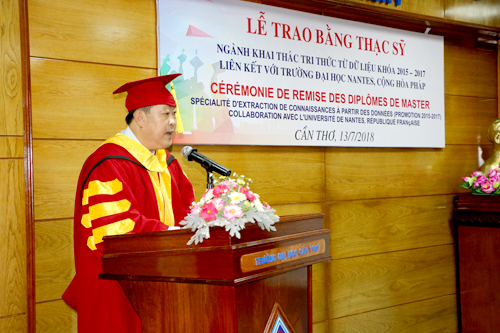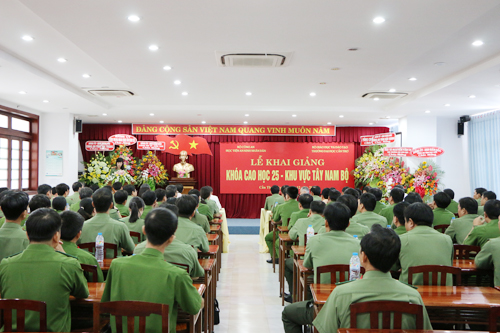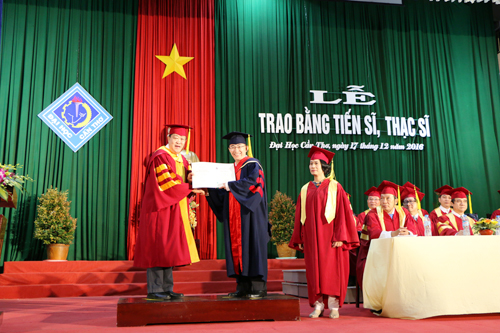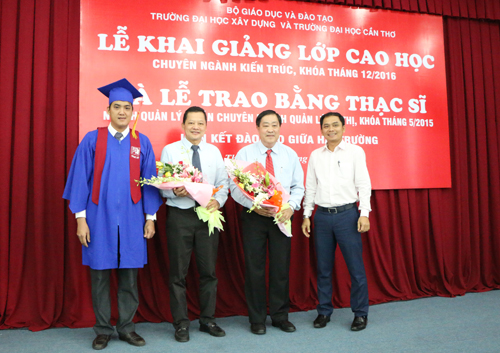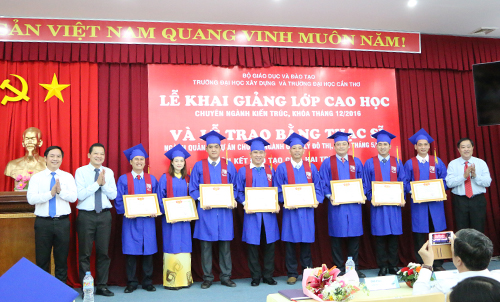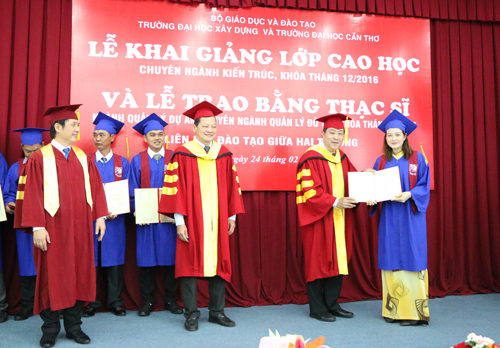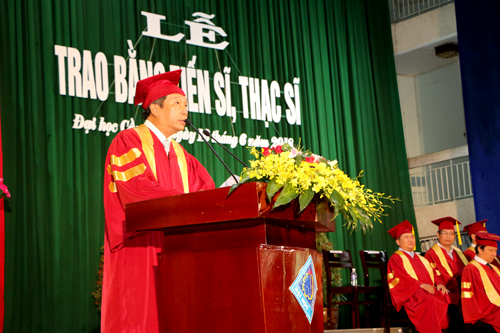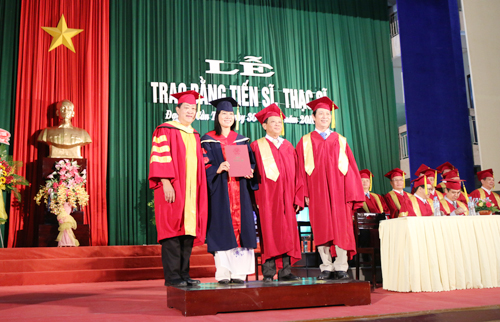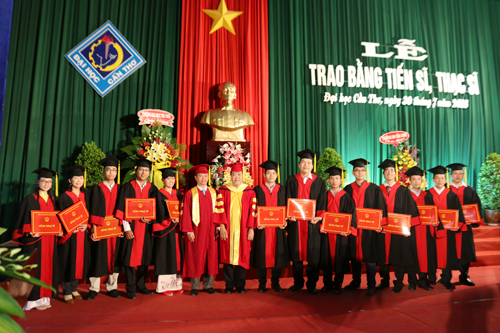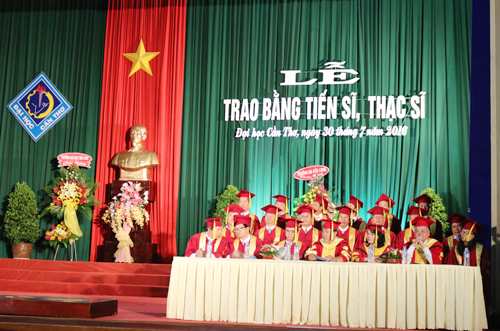
 Tên đề tài: “Đánh giá ô nhiễm thuốc bảo vệ thực vật trên ruộng lúa và các sông, rạch chính tại tỉnh Hậu Giang” .
Tên đề tài: “Đánh giá ô nhiễm thuốc bảo vệ thực vật trên ruộng lúa và các sông, rạch chính tại tỉnh Hậu Giang” .
 Tác giả: Nguyễn Phan Nhân, Khóa: 2012
Tác giả: Nguyễn Phan Nhân, Khóa: 2012
 Chuyên ngành: Môi trường đất và nước; Mã số: 9440303. Nhóm ngành: Môi trường
Chuyên ngành: Môi trường đất và nước; Mã số: 9440303. Nhóm ngành: Môi trường
 Người hướng dẫn chính: PGS.TS. Bùi Thị Nga, Trường Đại học Cần Thơ.
Người hướng dẫn chính: PGS.TS. Bùi Thị Nga, Trường Đại học Cần Thơ.
 Người hướng dẫn phụ: PGS.TS. Phạm Văn Toàn, Trường Đại học Cần Thơ.
Người hướng dẫn phụ: PGS.TS. Phạm Văn Toàn, Trường Đại học Cần Thơ.
- Tóm tắt nội dung luận án
Tỉnh Hậu Giang có thế mạnh về nông nghiệp với mô hình canh tác lúa 3 và 2 vụ.năm-1 đã tạo điều kiện cho sâu bệnh phát triển và thuốc bảo vệ thực vật (BVTV) được sử dụng với liều lượng và số lần phun thuốc cao hơn khuyến cáo. Nghiên cứu được thực hiện từ năm 2011 đến năm 2016 với mục tiêu là nghiên cứu biến động dư lượng thuốc BVTV trong nước, trong đất ruộng, trong bùn đáy kênh nội đồng, sông rạch nhằm đánh giá ô nhiễm thuốc BVTV giữa các loại hình thủy vực khác nhau và mối liên hệ giữa động vật đáy (ĐVĐ) với thuốc BVTV. Khảo sát thực trạng sử dụng thuốc BVTV tại khu vực nghiên cứu cho thấy có 97 tên thương mại thuộc 64 hoạt chất và 32 nhóm thuốc được sử dụng; trong đó, 5 hoạt chất được sử dụng phổ biến là propiconazole (nhóm triazole), quinalphos (lân hữu cơ), fipronil (phenylpyrazole), cypermethrin (cúc tổng hợp) và fenobucarb (carbamate). Lượng thuốc BVTV được sử dụng ở khu vực lúa 3 vụ.năm-1 là 3,88 Kg.ha-1 cao hơn so với khu vực lúa 2 vụ.năm-1 là 2,58 Kg.ha-1. Kết quả cho thấy dư lượng thuốc BVTV trên ruộng lúa và kênh nội đồng ở khu vực lúa 3 vụ.năm-1 cao hơn so với ở khu vực lúa 2 vụ.năm-1. Trung bình dư lượng các hoạt chất nghiên cứu trong nước giảm từ ruộng lúa ra kênh nội đồng ra sông rạch có giá trị dao động lần lượt là 0,06 – 4,55 µg.L-1; 0,02 – 1,6 µg.L-1 và 0,02 – 0,42 µg.L-1 tương ứng. Quinalphos và fenobucarb được tìm thấy trong nước đã tăng từ vụ lúa Đông – Xuân đến vụ Hè – Thu và Thu – Đông với giá trị dao động lần lượt là 0,02 – 0,12 µg.L-1; 0,08 – 0,26 µg.L-1 và 0,16 – 0,47 µg.L-1; một số điểm thu mẫu trên ruộng lúa và kênh nội đồng, quinalphos đã vượt ngưỡng gây độc cấp tính đối với ĐVĐ (EC50 = 0,6 µg.L-1). Trên các sông, rạch khảo sát (ngoại trừ rạch Mái Dầm), dư lượng thuốc BVTV trong nước đã vượt quy chuẩn Châu Âu về chất lượng nước uống (0,1 µg.L-1); không phát hiện cypermethrin trong nước. Dư lượng thuốc BVTV trong đất ruộng lúa là 6,78 – 179,34 µg.Kg-1 và trên kênh nội đồng là 5,38 – 145,23 µg.Kg-1 cao hơn so với trên sông rạch là 4,59 – 86,18 µg.Kg-1. Thành phần loài động vật đáy thấp nhất trên ruộng lúa là 15 loài, trên kênh nội đồng là 32 loài và cao nhất trên sông rạch là 43 loài. Chỉ số SPEARpesticides trên kênh nội đồng với giá trị là 8,34 thấp hơn so với trên sông rạch là 25,31. Các thuỷ vực kênh nội đồng có số lượng ĐVĐ không bị rủi ro với thuốc là 12 họ cao hơn so với số lượng ĐVĐ bị rủi ro với thuốc là 4 họ; thuỷ vực sông rạch bị ảnh hưởng bởi thuốc BVTV có số lượng ĐVĐ bị rủi ro và số lượng ĐVĐ không bị rủi ro với thuốc chênh lệch không đáng kể lần lượt là 8 họ và 9 họ. Chỉ số SPEARpesticides tương quan nghịch với dư lượng thuốc BVTV với hệ số tương quan là R = -0,68 (p < 0,01). Các chỉ tiêu lý – hóa nước, đất và bùn đáy gồm nhiệt độ, DO (nồng độ oxy hoà tan), pH, EC, hàm lượng chất hữu cơ và sa cấu đất khác biệt không đáng kể giữa các loại hình thuỷ vực. Nghiên cứu sự lan truyền của thuốc bảo vệ thực vật trên các loại hình thuỷ vực bị ảnh hưởng bởi canh tác lúa cần thiết được thực hiện.
- Những kết quả mới của luận án
Xác định dư lượng thuốc BVTV thuộc 5 hoạt chất được sử dụng phổ biến tại tỉnh Hậu Giang gồm propiconazole (thuộc nhóm triazole), fipronil (phenylpyrazole), quinalphos (lân hữu cơ), fenobucarb (carbamate) và cypermethrin (cúc tổng hợp) trong nước, trong đất và trong bùn đáy từ ruộng lúa ra kênh nội đồng và sông, rạch tiếp nhận nước thải từ kênh nội đồng.
Xác định thành phần loài và số lượng cá thể ĐVĐ từ trong ruộng lúa đến kênh nội đồng và sông rạch tiếp nhận.
Đánh giá được mối liên hệ giữa dư lượng thuốc BVTV với động vật đáy trên các loại hình thuỷ vực chịu ảnh hưởng bởi canh tác lúa tại Hậu Giang và xác định chỉ số SPEARpesticides dựa vào ĐVĐ ở mức độ họ phản ánh tình trạng của các loại hình thuỷ vực có động vật đáy bị rủi ro với thuốc trên địa bàn tỉnh Hậu Giang.
- Khả năng ứng dụng trong thực tiễn và các vấn đề cần tiếp tục nghiên cứu
- Khả năng ứng dụng trong thực tiễn
Cung cấp số liệu về dư lượng thuốc BVTV trong nước, đất ruộng lúa và bùn đáy trên kênh nội đồng và sông rạch là cơ sở đánh giá tình hình ô nhiễm thuốc BVTV trong nước, đất và bùn đáy, phục vụ cho công tác quan trắc dư lượng thuốc BVTV trên địa bàn Tỉnh.
Phân tích, đánh giá được mối liên hệ giữa dư lượng thuốc BVTV với động vật đáy và tình trạng của các loại hình thuỷ vực bị ảnh hưởng bởi thuốc BVTV dựa vào chỉ số SPEARpesticides.
- Các vấn đề cần tiếp tục nghiên cứu
Nghiên cứu sử dụng đồng vị xác định dư lượng thuốc BVTV trên các thuỷ vực bị ảnh hưởng bởi canh tác lúa tại tỉnh Hậu Giang.
Nghiên cứu mô hình hoá đánh giá sự lan truyền của thuốc bảo vệ thực vật trên các loại hình thuỷ vực bị ảnh hưởng bởi canh tác lúa trên địa bàn Tỉnh.
Project title: Determination of pesticide residues in the rice fields and the main rivers in Hau Giang, Viet Nam.
Major: Land and Water Environment Identification code: 9440303
Full Name: Nguyen Phan Nhan
Scientific advisors: Assoc. Prof. Bui Thi Nga
Scientific advisors: Assoc. Prof. Pham Van Toan
Implementing Institution: College of Environment & Natural Resources, Can Tho University.
- Summary
Hau Giang has been an agriculture-based province with two patterns consisting of triple- and double-rice crop per year which has caused pest outbreaks and pesticide use with dose and application frequency exceeding the recommendation instructed on pesticide container labels. The study was carried out from 2011 to 2016 to investigate changes in residue of pesticides in surface water, soil and sediment in rice fields, irrigation canals and rivers in order to assess pesticide contamination in water bodies surveyed; relationship between richness and abundance of benthic-invertebrates and the pesticide residues. The status of pesticide used at Hau Giang showed that 97 pesticide trade names corresponding to 64 active ingredients (a.i) from 32 chemical groups were used, of which the five most commonly used active ingredients were propiconazole (triazole), quinalphos (organophosphate), fipronil (phenylpyrazole), cypermethrin (pyrethroid) and fenobucarb (carbamate). The amount of pesticides used occupying of 3.88 Kg.ha-1 were higher in the triple-crop pattern than in the double-crop pattern with value of 2.58 Kg.ha-1. The results illustrated that the residue of pesticides in the field- and the canal-waters were higher in the triple-crop pattern than in the double-crop pattern. The mean concentration of the active ingredients surveyed in water decreased from the fields to the canals and the rivers, ranging from 0.06 to 4.55 µg.L-1, from 0.02 to 1.6 µg.L-1 and from 0.02 to 0.42 µg.L-1 respectively. The residues of quinalphos and fenobucarb in water increased from winter-spring to summer-autumn and autumn-winter with value of 0.02 – 0.12 µg.L-1; 0.08 – 0.26 µg.L-1 and 0.16 – 0.47 µg.L-1 respectively. In the fields and the canals, a number of water samples were contaminated quinalphos exceeding median effective concentration for benthic-invertebrates (EC50 = 0.6 µg.L-1). The pesticide residues in the rivers surveyed (excepted Mai Dam river) were higher than maximum concentration level for drinking water regulated by the Europe committee (0.1 µg.L-1). Cypermethrin was not detected in all surface water samples. The mean content of pesticides ranging from 6.78 to 179.34 µg.Kg-1 in the field-soils and from 5.38 to 145.23 µg.Kg-1 in the canal-sediments were higher than in the river-sediments with value of 4.59 – 86.18 µg.Kg-1. The richness of benthic-invertebrates in the fields with 15 species was less abundant than in the canals with 32 species and in the rivers with 43 species. The pesticide-specific SPEARpesticides bio-index with value of 8.34 was lower in the canals than in the rivers with value of 25.31. In the canals, the number of families “not at risk” were more abundant than the number of families “at risk” occupying of 12 and 4 families respectively, while in the rivers the number of families “at risk” and “not at risk” with 8 and 9 families respectively were insignificantly different. The family-level SPEARpesticides was negatively correlated with the pesticide residues with correlation coefficient of R = -0.68 (p < 0.01). The physico-chemical variables of surface water, soil and sediment including temperature, dissolved oxygen (DO), pH, electrical conductivity (EC), organic matters and soil texture were not significantly different in the water bodies surveyed. Study on application of the models of pesticide transportation in assessment of water pollution in the agricultural streams needs to be conducted.
- Creativeness of the study
Changes in residue of the five most commonly used active ingredients as propiconazole (triazole), quinalphos (organophosphate), fipronil (phenylpyrazole), cypermethrin (pyrethroid) and fenobucarb (carbamate) in surface water, soil and sediment from the rice fields to the irrigation canals and the rivers received wastewater drained from the canals surveyed.
Determination of the richness and abundance of benthic-invertebrates from the rice fields to the irrigation canals and the rivers.
Relationship between the richness and abundance of the benthic-invertebrates and the pesticide residues in the water bodies surveyed; application of the pesticide-specific SPEARpesticides bio-index based on the family level of taxa to definition of ecological status of water bodies derived for families “at risk” from pesticides at Hau Giang.
- Applicability and Recommendations
- Applicability in practice
Supplying adequate database of the pesticide residues in water, in soil in the rice fields and sediment in the canals and the rivers to assess the pesticide contamination in the water bodies surveyed and initially contribute to provincial programs of the pesticide-specific monitoring at Hau Giang.
Assessing relationship between the pesticide residues and the benthic-invertebrates; the ecological status of the water bodies contaminated pesticides based on the family-level SPEARpessticides bio-index.
- Recommendation for farther studies
Study on using stable isotopes for detection of pesticide residues in the water bodies influenced by agricultural activities at Hau Giang.
Study on application of the models of pesticide transportation in assessment of water pollution in the agricultural streams at Hau Giang.
>> Xem chi tiết nội dung luận án
>> Xem thông tin đăng tải tại Website Bộ giáo dục và Đào tạo.





